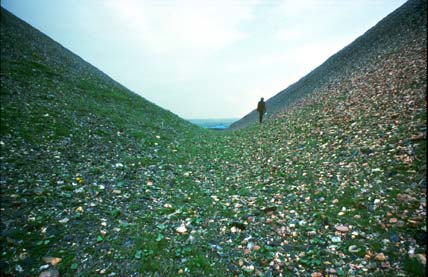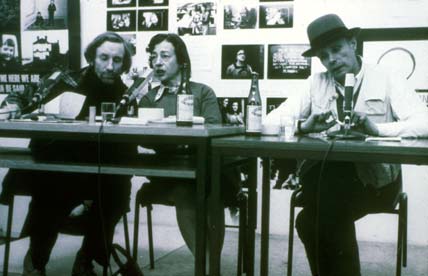
|
The Destruction In Art Symposium (DIAS) is held at the Africa Centre in Covent Garden, London, bringing together a diverse group of artists including Barbara Steveni, John Latham and Stuart Brisley.
The APG is formed in London by Barbara Steveni in collaboration with John Latham; they are joined by Jeffrey Shaw, Barry Flanagan, Stuart Brisley, David Hall, Anna Ridley and Maurice Agis, as well as Ian McDonald Munro.
|
| back to top |

|
The first APG initiated event, the Industrial
Negative Symposium, is held at the Mermaid Theatre, London.
Barbara Steveni approaches the chairman of the Arts Council, Lord
Goodman, and the secretary general, Sir Hugh Willatt, to request
use of the Hayward Gallery for an exhibition. They agree.
The APG meets with the EAT (Experiments in Art & Technology),
a different artist group whose mandate centres around collaborating
with corporations to improve industrial and artistic fabrication. |
| back to top |

|
The artist Garth Evans undertakes the first
industrial placement with British Steel Corporation. He goes into
Port Talbot, a large steel producing complex in the UK, and interviews
apprentices on-site, culminating in a paper for the Iron and Steel
Federation as well as reports for the corporation.
|
| back to top |

|
The artist David Hall is given an industrial placement with British European Airways; he films unique cloud formations over the Rock of Gibraltar and elsewhere throughout Europe. Hall also initiates a placement with Scottish Television.

David Hall on his B.E.A. placement filming cloud formations over the Swiss Alps.
© APG/Tate Archive/The artist.
Other placements successfully negotiated by the APG include: Stuart
Brisley working for Hillie Co Ltd, Leonard Hessing working with
ICI Fibres Ltd, Lois Price working with Milton Keynes Development
Corporation, Ian Monro and Marie Yates joining Brunei University.
In addition, John Latham takes up placements with the National Coal
Board as well as in the Intensive Care Unit of Clare Hall Hospital.
Between 6 is held at the Kunsthalle in Dusseldorf, where
the APG discusses one of their central contentions that ‘context
is half the work’. They are invited by Jürgen Harten, Director
of the Kunsthalle, to explain their initiatives to representatives
from German industry.
The artist Ian Breakwell takes an industrial placement with British
Rail and produces a film called The Journey. The artist
David Parsons also undertakes a placement with British Rail and
John Latham takes a placement with Proteus Byging Co.

Film still from The Journey, made by
Ian Breakwell on an APG placement with British Rail.
© APG/Tate Archive.
The artist Andrew Dipper undertakes a placement with Esso Petroleum
Co Ltd. He produces a series of photographs and super-eight films
documenting life at sea.
|
| back to top |

|

Catalogue cover for Hayward Gallery exhibition Art and Economics
held in 1971. © APG/Tate Archive |
Art & Economics exhibition
opens at the Hayward Gallery and is unofficially curated by the
APG who literally move into the gallery. A selection of documentation
from the APG’s industrial placements are displayed as works
of art. In one gallery, interviews are set up between industrialists
and artists to question the new role of the artist in society.
|
| back to top |

|
The Arts Council discontinues funding on
the basis that the ‘APG is more concerned with Social Engineering
than with pure art’.
Barbara Steveni negotiates the Whitehall Memorandum with
the UK government, documenting the support of artist placements
within government institutions. It is agreed that there is a bilateral
interest between artist activity and government activity which later
leads to a number of APG placements.
The APG sets up an office on Ealham Street in Covent Garden, London. |
| back to top |

|
A placement is arranged between the Greek
artist George Levantis and the shipping company, Ocean Fleets. Levantis
travels on an ocean liner, a tanker and a cargo ship. As a result
of this experience he produces an art installation which is thrown
overboard, as well as a poetic book.
|
| back to top |

|
The artist Roger Coward is given the first
government placement with the Department of the Environment in Birmingham.
He moves to Small Heath with a team of actors and uses film to
enable residents to respond directly to the Department of Environment’s
proposals.
The New Profession is held at the Garage Gallery, London.
Each artist exhibits the work produced on placements, and their
roles are discussed with representatives from organisations currently
holding placements with artists.
The artist Jeffrey Shaw is given a placement with National Bus
Co. John Latham works with the Scottish Office and Lois Price works
with Milton Keynes Development Corporation. Stuart Brisley also
takes a placement with the Peterlee Development Corporation.

The artist, John Latham, and a detail of shale
deposit from his work Five Sisters. It was produced by
Latham during his Scottish Office placement in 1975. © APG/Tate Archive
Artist Ian Breakwell undertakes a placement with the Department
of Health and Social Security. He produces a series of controversial
films on Broadmoor Special Hospital for the criminally insane. |
| back to top |

|
Art critic John A Walker publishes an important
article about the APG in Studio International, explaining the group’s
long-term objectives and desire to change the role of the artist.
|
| back to top |

|
The APG holds a series of seminars and presentations
across London at the Royal College of Art, Riverside Studios and
the Whitechapel Art Gallery.
Joseph Beuys invites John Latham to discuss artist-with-government
placements at Documenta 6 in Kassel. This is when the APG is first
brought to the attention of the German government.

Joseph Beuys and John Latham at the Kunsteverin in Bonn, Germany. © APG/Tate Archive
APG holds a series of podium exchanges with the German government
and secretaries of state in Bonn which leads to the first international
artist-with-government placement. Further discussions and a presentation
are later held at the Rat Haus and the Stadhaus. |
| back to top |

|
The APG meet with Austrian artists and government
at the Palais Lichtenstein.
|
| back to top |

|
The APG gives a presentation in France at
the Musée d’Art Moderne in Paris, arranged by the British
Council.
|
| back to top |

|
The APG is invited by Sir Reginald Hibbart
from the British Embassy in Paris, to introduce the idea in France.
|
| back to top |

|
The APG holds a discussion with Dutch artists
and members from regional government at the Apollohuis in Eindhoven,
Holland.
The first European APG placement is organized for John Latham and
Klaus vom Bruch. It is a traffic safety project with Nordrhein Westfalen
in Düsseldorf, where they take a comparative look at the way that
accidents happen.
|
| back to top |

|
Barbara Steveni and Nicholas Tresilian establish
a pilot European placement programme funded by the EEC Cultural
Sector.
|
| back to top |

|
Barbara Steveni establishes the O + I (Organisation
and Imagination) as an independent international artist consultancy
and research body.
Artists John Latham, Barbara Steveni, Rita Keegan, Carlyle Reedy and David Carr are invited to the Southwark Education Research Project by the Inner London Education Authority and the London Borough of Southwark. Together they look at the role of contemporary art in relation to learning and educational restructuring.
|
| back to top |

|
Barbara Steveni establishes a european network to reposition the artist in the decision-making process of government, commerce and academia at the inaugural meeting of ELIA in Amsterdam.
|
| back to top |

|
Barbara Steveni establishes an Erasmus programme
Art in Context at the London Institute in collaboration
with colleagues in Norway, Spain and Holland
|
| back to top |
|

Barbara Steveni outside of the Department of Culture, 2001. © APG/Tate Archive
|

|
Tate Archive Collection becomes the home
for the Artist Placement Group’s Archive
|
| back to top |

|
The APG, which now exists as O+I, holds
a day-long event at Tate Britain.
|
